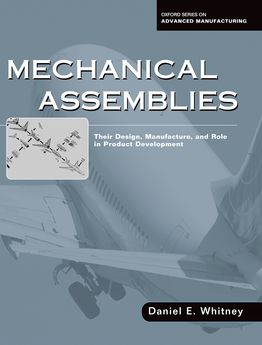Each chapter ends with problems and Thought Questions, Further Reading, a Summary and an Index. Most chapters include Appendices.
1. What is Assembly and Why is it Important?
1.1.Introduction
1.2.Some Examples
1.3.Assembly in the Context of Product Development
1.4.Assembling a Product
1.5.History and Present Status of Assembly
1.6.Assemblies Are Systems
2. Assembly Requirements and Key Characteristics
2.1.Prolog
2.2.Product Requirements and Top-Down Design
2.3.The Chain of Delivery of Quality
2.4.Key Characteristics
2.5.Variation Risk Management
2.6.Examples
2.7.Key Characteristics Conflict
3. Mathematical and Feature Models of Assemblies
3.1.Introduction
3.2.Types of Assemblies
3.3.Matrix Transformations
3.4.Assembly Features and Feature-based Design
3.5.Mathematical Models of Assemblies
3.6.Example Assembly Models
4. Constraint in Assembly
4.1.Introduction
4.2.The Stapler
4.3.Kinematic Design
4.4.Features as Carriers of Constraint
4.5.Use of Screw Theory to Represent and Analyze Constraint
4.6.Design and Analysis of Assembly Features Using Screw Theory
5. Dimensioning and Tolerancing Parts and Assemblies
5.1.Introduction
5.2.History of Dimensional Accuracy in Manufacturing
5.3.KCs and Tolerance Flowdown From Assemblies to Parts: An Example
5.4.Geometric Dimensioning and Tolerancing
5.5.Statistical and Worst Case Tolerancing
6. Modeling and Managing Variation Buildup in Assemblies
6.1.Introduction
6.2.Nominal and Varied Models of Assemblies Represented by Chains of Frames
6.3.Representation of GD&T Part Specifications as 4x4 Transforms
6.4.Examples
6.5.Tolerance Allocation
6.6.Variation Buildup in Sheet Metal Parts
6.7.Variation Reduction Strategies
7. Assembly Sequence Analysis
7.1.Introduction
7.2.History of Assembly Sequence Analysis
7.3.The Assembly Sequence Design Process
7.4.The Bourjault Method of Generating All Feasible Sequences
7.5.The Cutset Method
7.6.Checking the Stability of Subassemblies
7.7.Software for Deriving Assembly Sequences
7.8.Examples
8. The Datum Flow Chain
8.1.Introduction
8.2.History and Related Work
8.3.Summary of the Method for Designing Assemblies
8.4.Definition of a DFC
8.5.Mates and Contacts
8.6.Type-1 and Type-2 Assemblies Example
8.7.KC Conflict and Its Relation to Assembly Sequence and KC Priorities
8.8.Example Type-1 Assemblies
8.9.Example Type-2 Assemblies
8.10.Summary of Assembly Situations That Are Addressed by The DFC Method
8.11.Assembly Precedence Constraints
8.12.DFCs, Tolerances, and Constraint
8.13.A Design Procedure for Assemblies
8.14.Summary of Kinematic Assembly
9. Assembly Gross and Fine Motions
9.1.Prolog
9.2.Kinds of Assembly Motions
9.3.Force Feedback in Fine Motions
9.4.Problems
10. Assembly of Compliantly Supported Rigid Parts
10.1.Introduction
10.2.Types of Rigid Parts and Mating Conditions
10.3.Part Mating Theory for Round Parts with Clearance and Chamfers
10.4.Chamberless Assembly
10.5.Screw Thread Mating
10.6.Gear Mating
11. Assembly of Compliant Parts
11.1.Introduction
11.2.Design Criteria and Considerations
11.3.Rigid Peg/Compliant Hole Case
11.4.Design of Chamfers
11.5.Correlation of Experimental and Theoretical Results
12. Assembly in the Large: The Impact of Assembly on Product Development
12.1.Introduction
12.2.Concurrent Engineering
12.3.Product Design and Development Decisions Related to Assembly
12.4.Steps in Assembly in the Large
13. How To Analyze Existing Products in Detail
13.1.How to Take a Product Apart and Figure Out How It Works
13.2.How to Identify the Assembly Issues in a Product
13.3.Examples
14. Product Architecture
14.1.Introduction
14.2.Definition and Role of Architecture in Product Development
14.3.Interaction of Architecture Decisions and Assembly in the Large
14.4.Examples
15. Design for Assembly and Other Ilities
15.1.Introduction
15.2.History
15.3.General Approach to DFM/DFA
15.4.Traditional DFM/DFA (DFx in the Small)
15.3.DFx in the Large
15.4.Example DFA Analysis
15.5.DFx's Place in Product Design
16. Assembly System Design
16.1.Introduction
16.2.Basic Factors in System Design
16.3.Available System Design Methods
16.4.Average Capacity Equations
16.5.Three Generic Resource Alternatives
16.6.Assembly System Architectures
16.7.Quality Assurance and Quality Control
16.8.Buffers
16.9.The Toyota Production System
16.10.Discrete Event Simulation
16.11.Heuristic Manual Design Technique for Assembly Systems
16.12.Analytical Design Technique
16.13.Example Lines from Industry: Sony
16.14.Example Lines from Industry - Denso
16.15.Example Lines from Industry - Aircraft
17. Assembly Workstation Design Issues
17.1.Introduction
17.2.What Happens in an Assembly Workstation
17.3.Major Issues in Assembly Workstation Design
17.4.Workstation Layout
17.5.Some Important Decisions
17.6.Other Important Decisions
17.7.Assembly Station Error Analysis
17.8.Design Methods
17.9.Examples
18. Economic Analysis of Assembly Systems
18.1.Introduction
18.2.Kinds of Cost
18.3.The Time Value of Money
18.4.Interest Rate, Risk, and Cost of Capital
18.5.Combining Fixed and Variable Costs
18.6.Cost Models of Different Assembly Resources
18.7.Comparing Different Investment Alternatives
19. Case Study of Aircraft Wing Manufacture
19.1.Introduction
19.2.Boeing 767 Wing Skin Subassembly Case
19.3.Type-1 and Type-2 Methods of Final Wing Assembly
